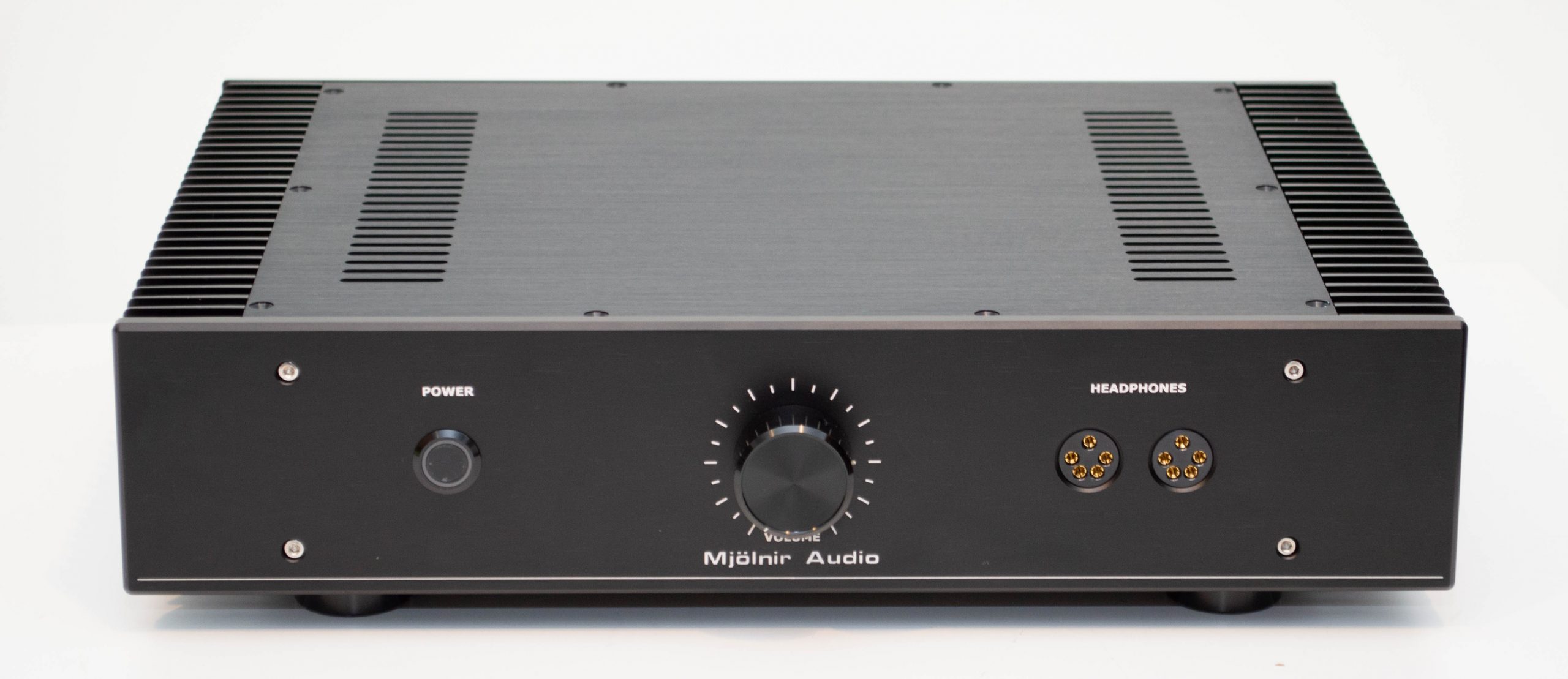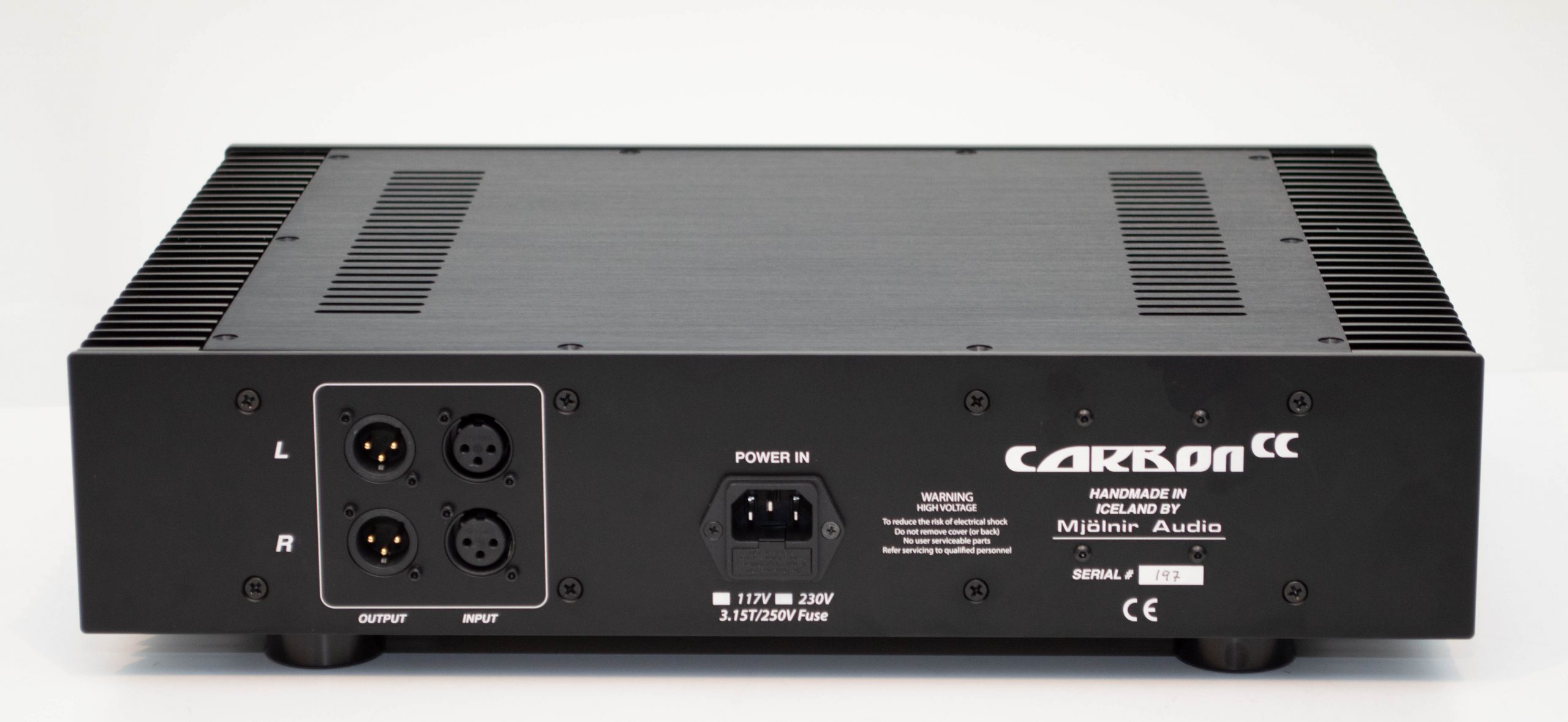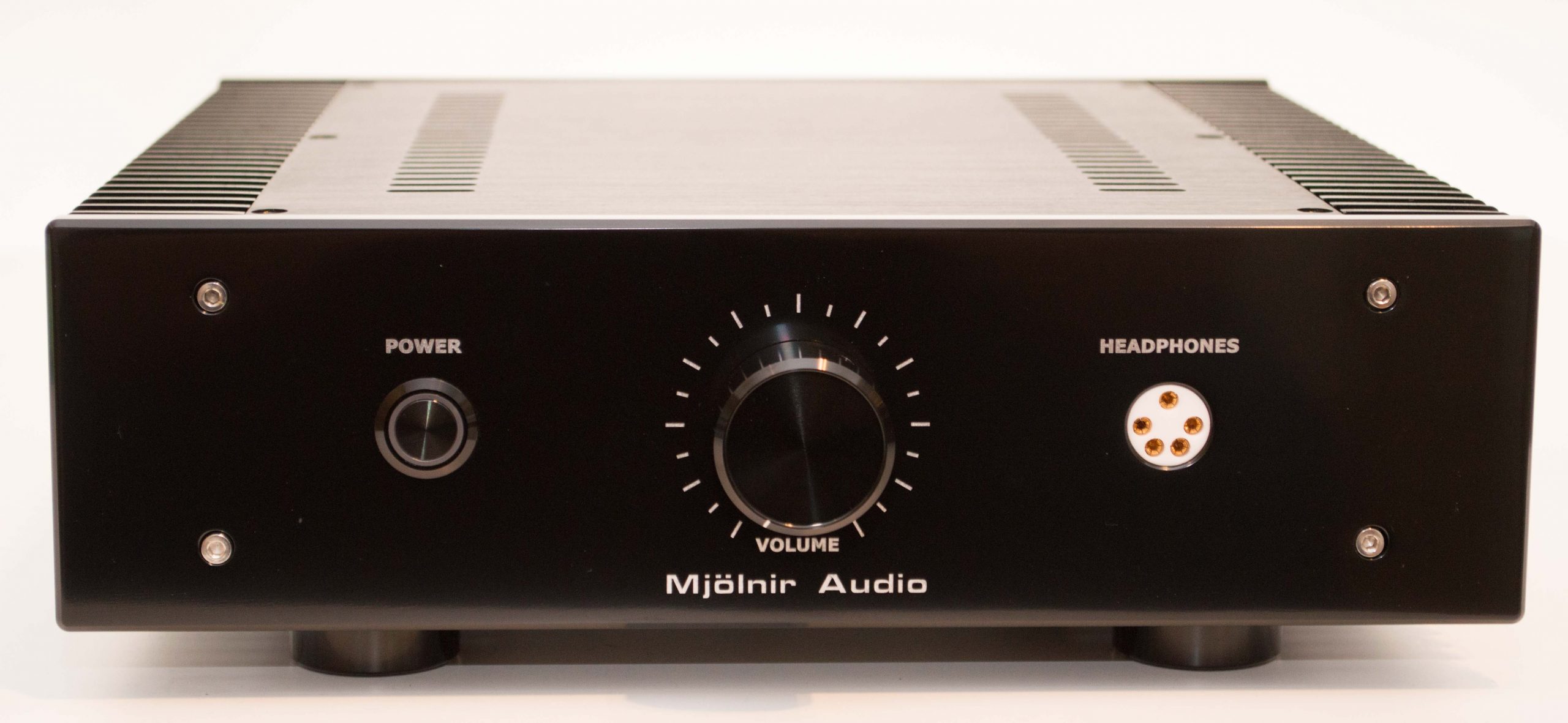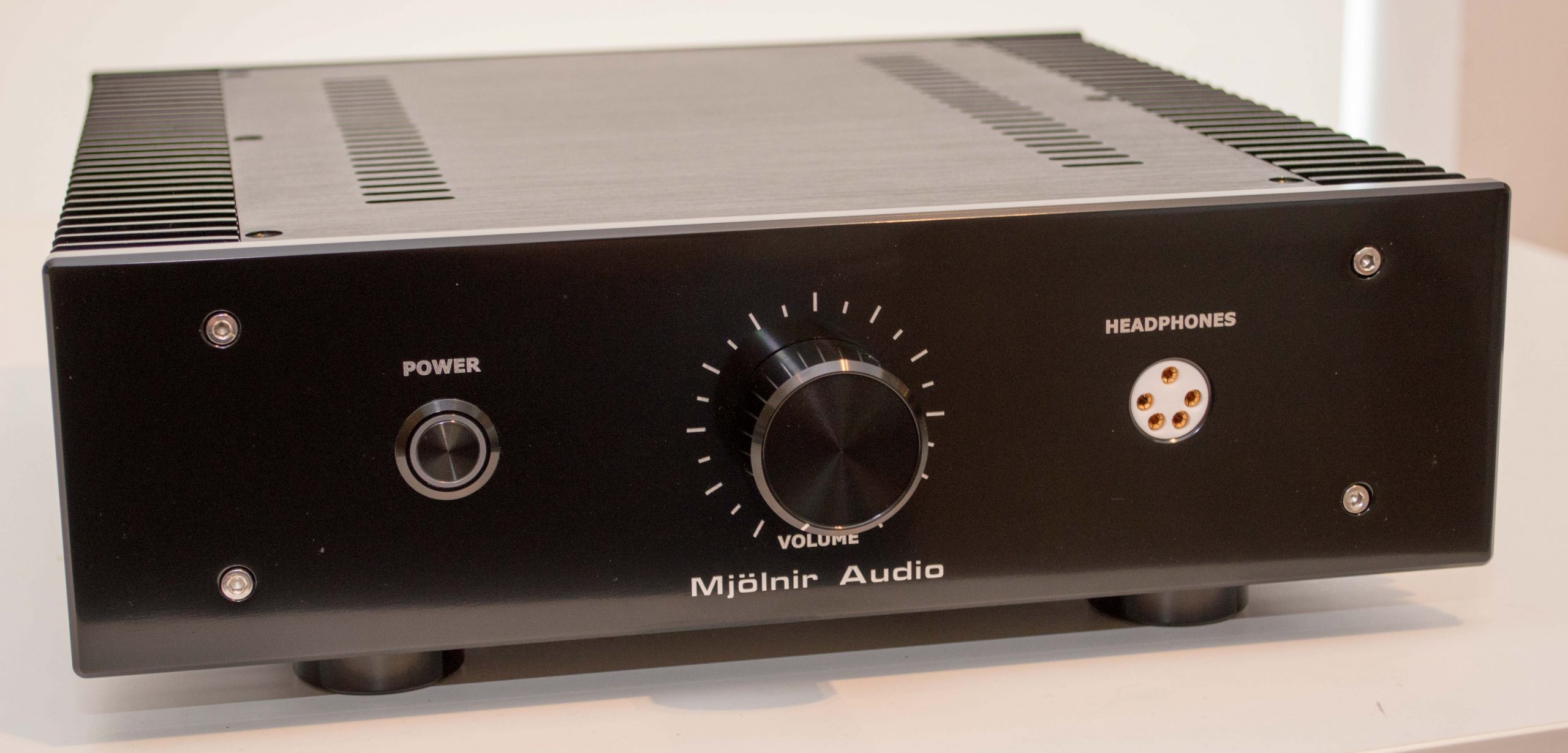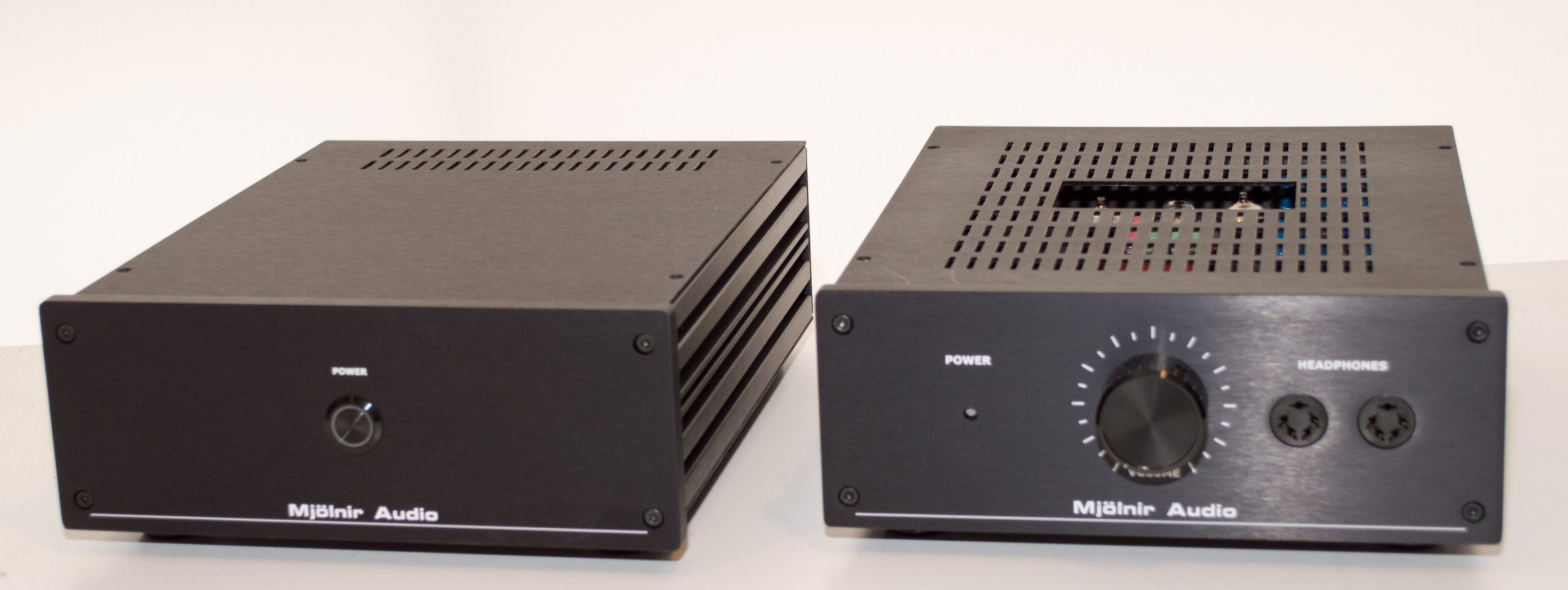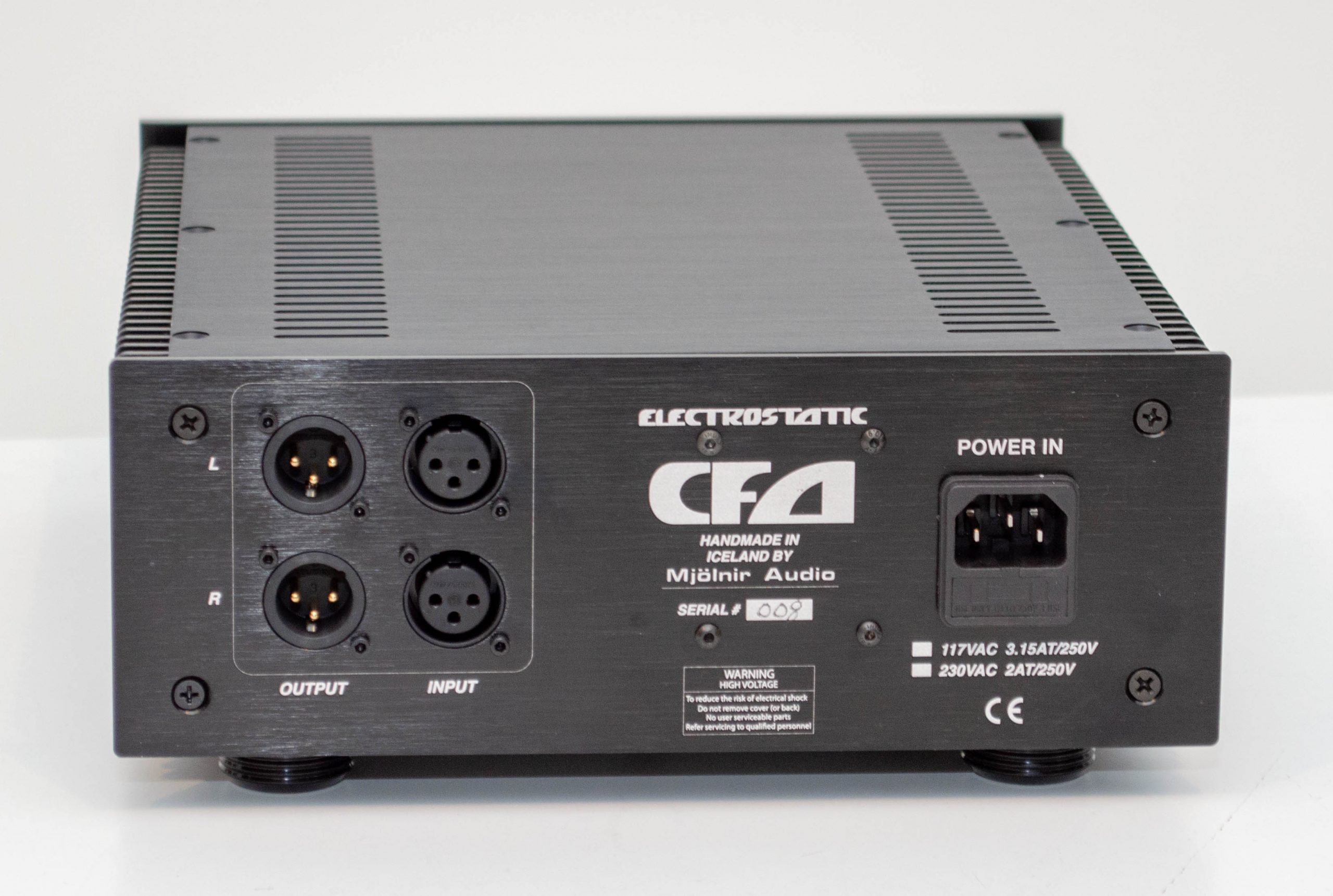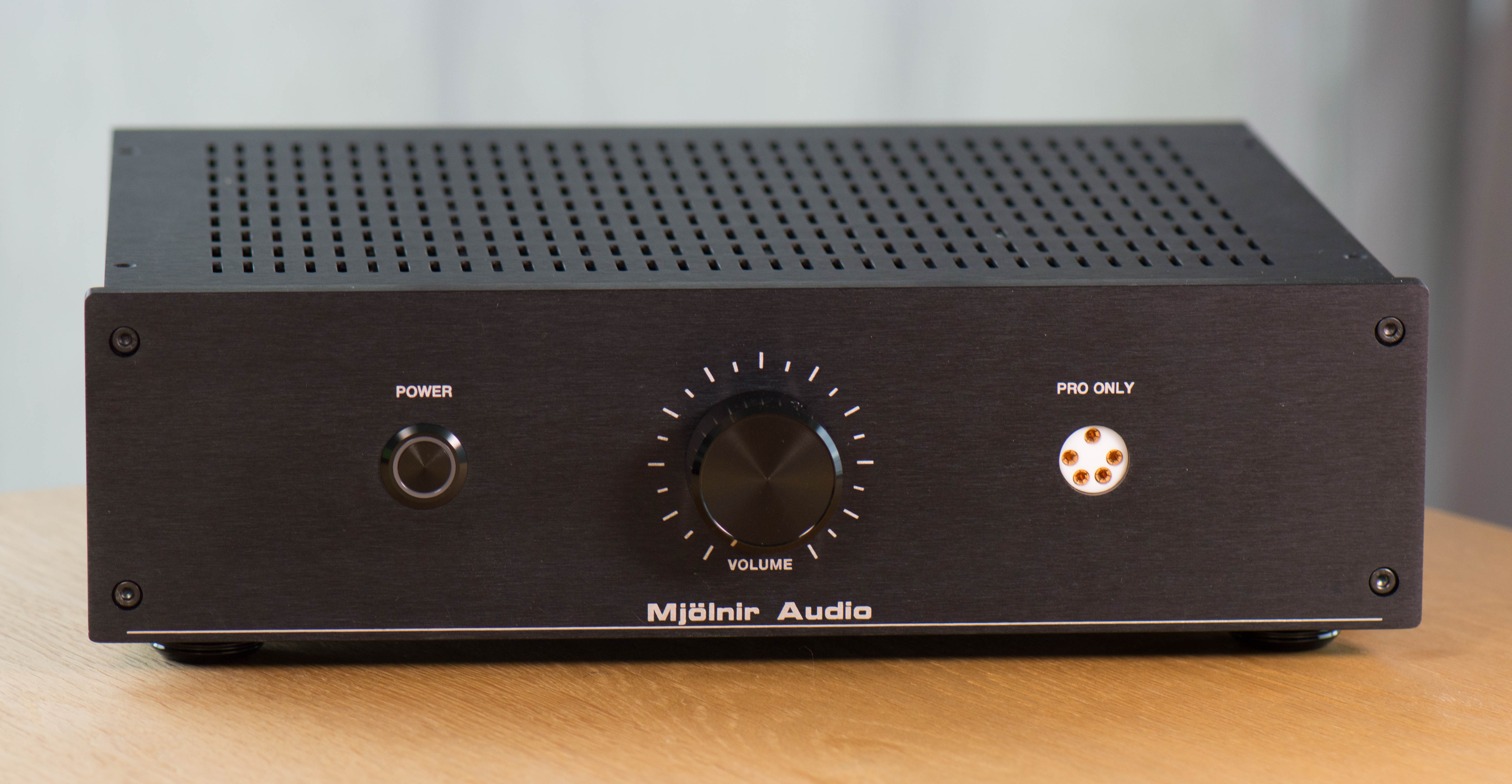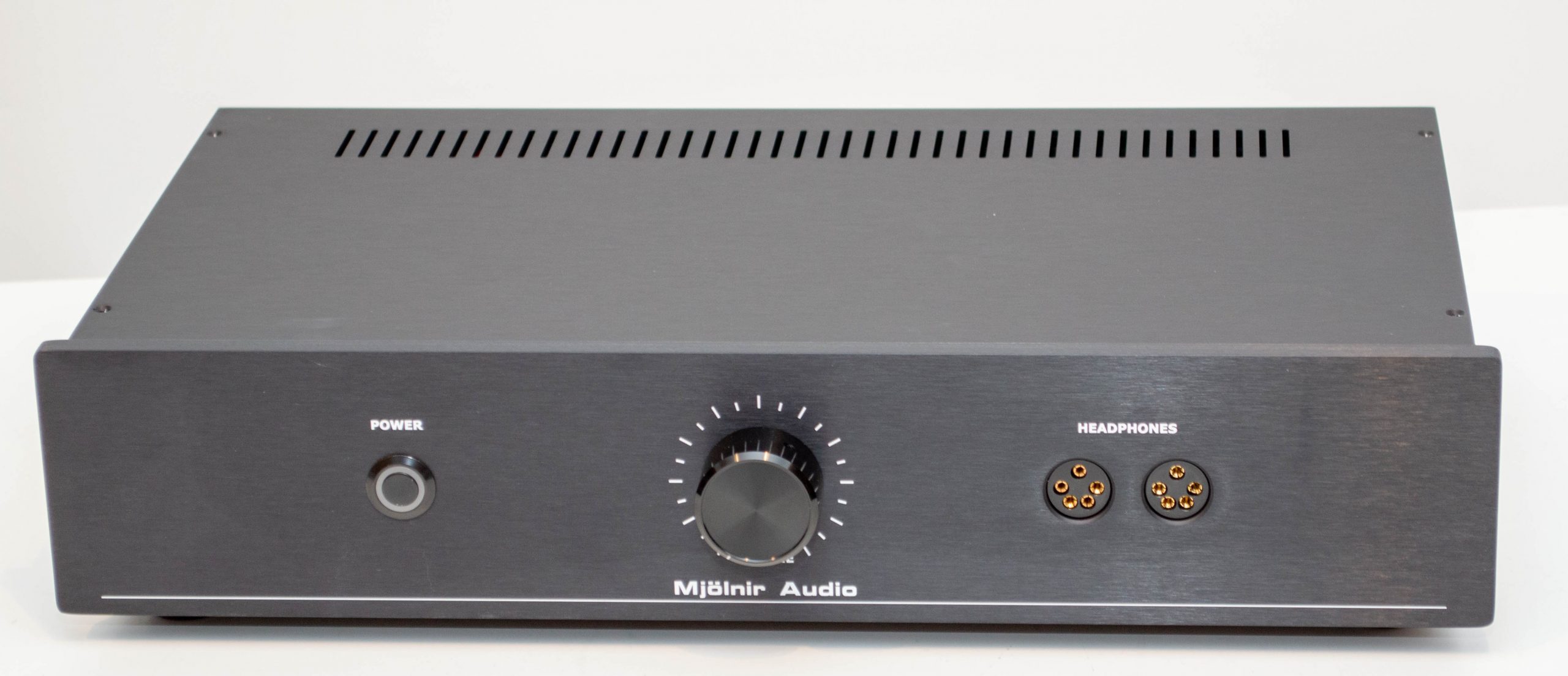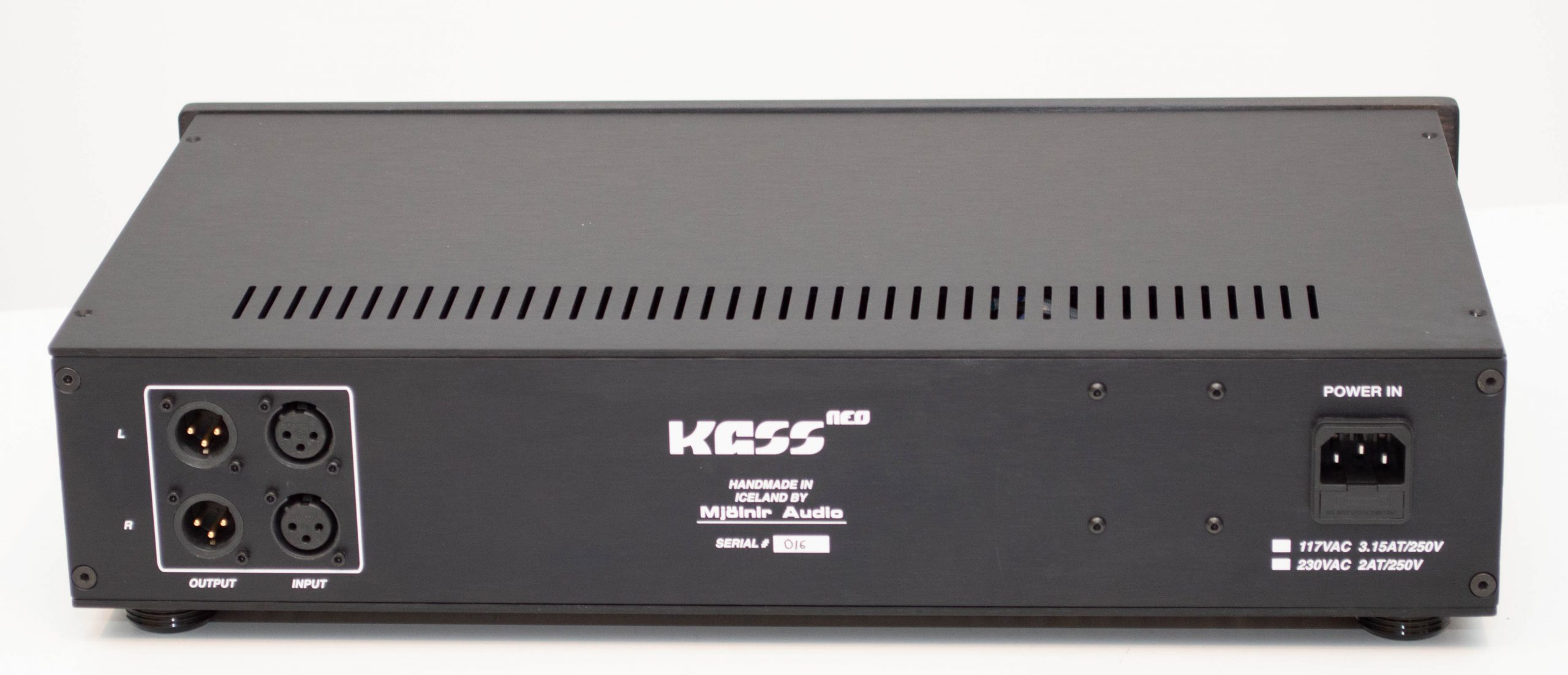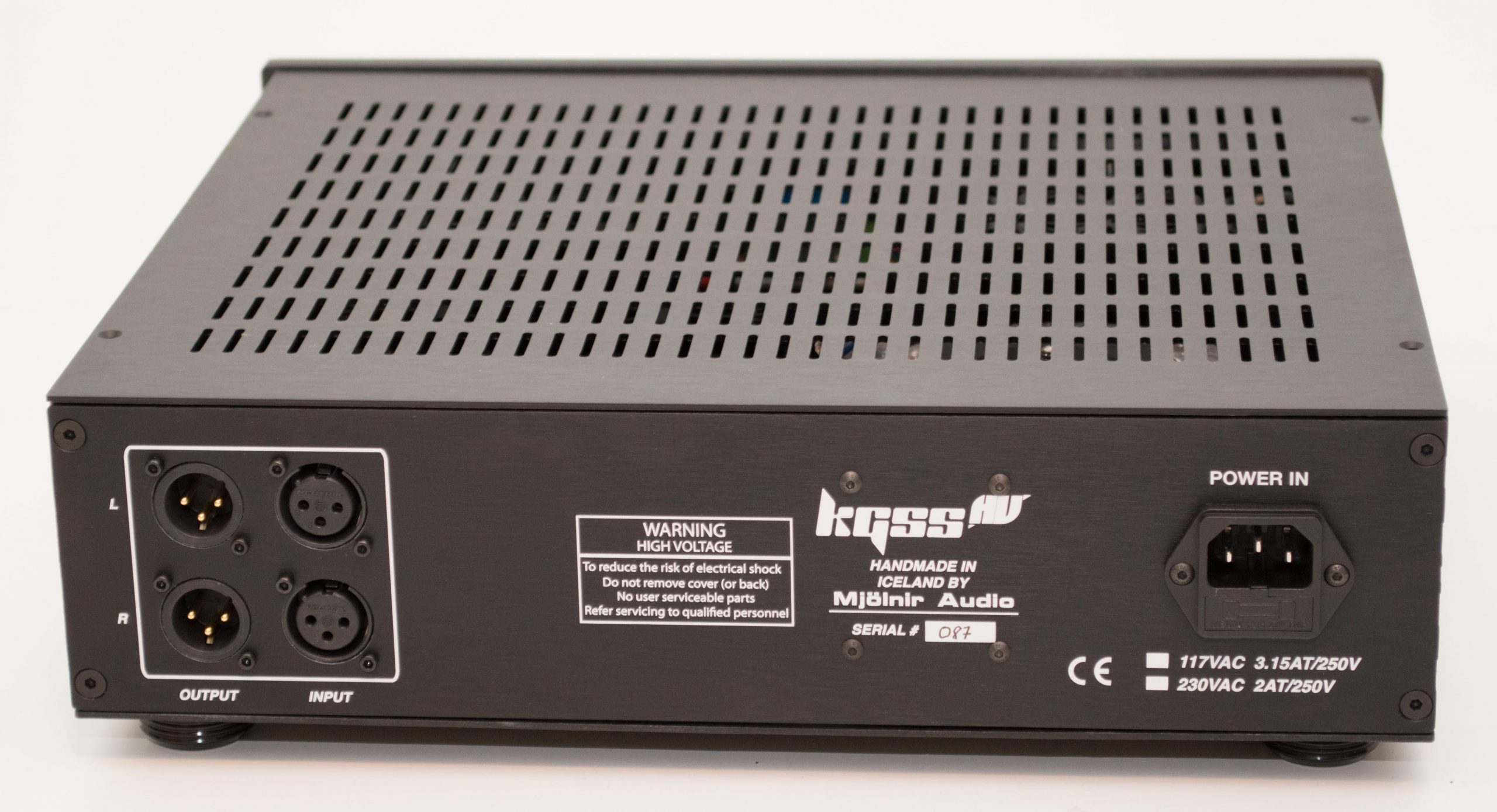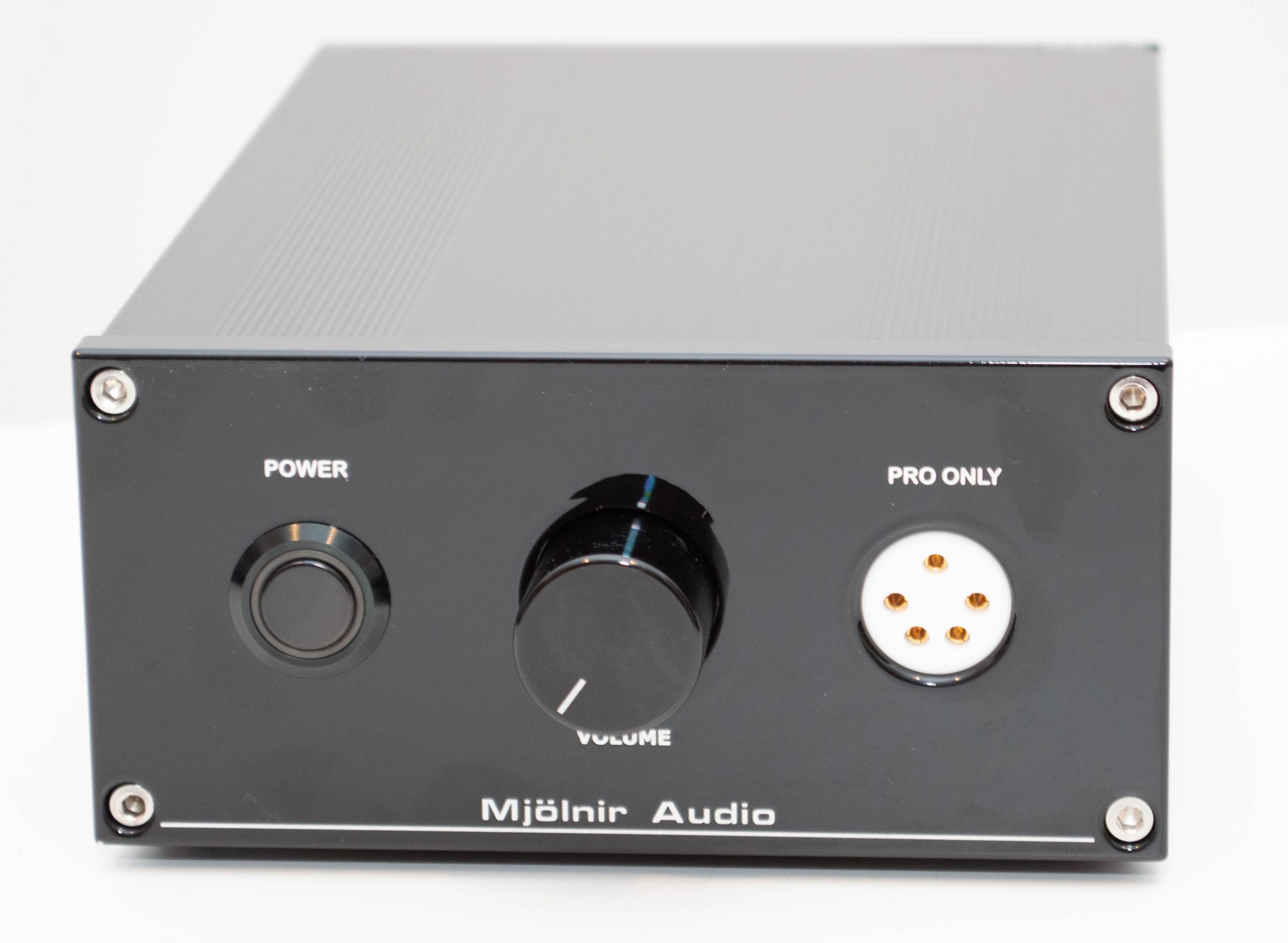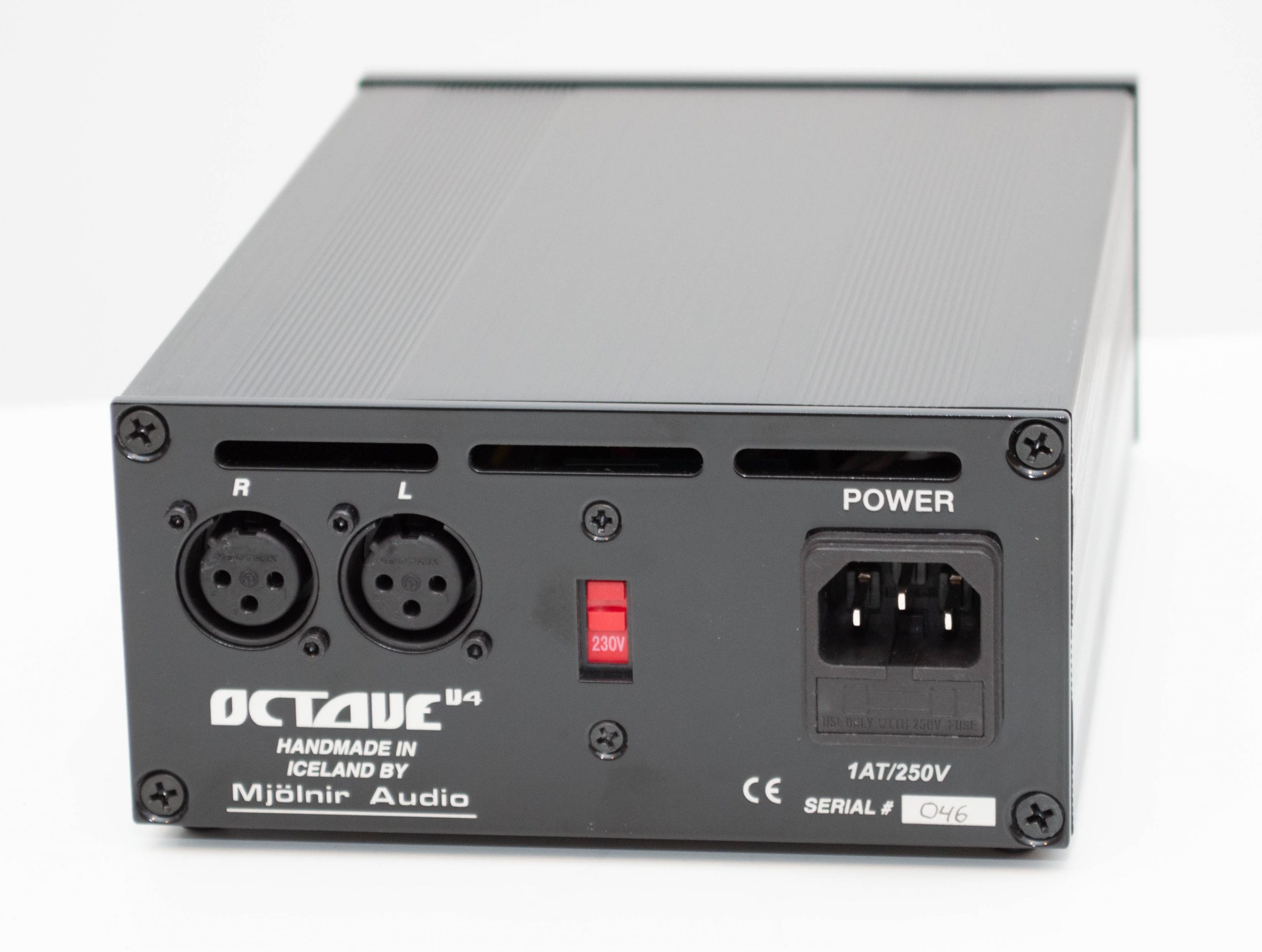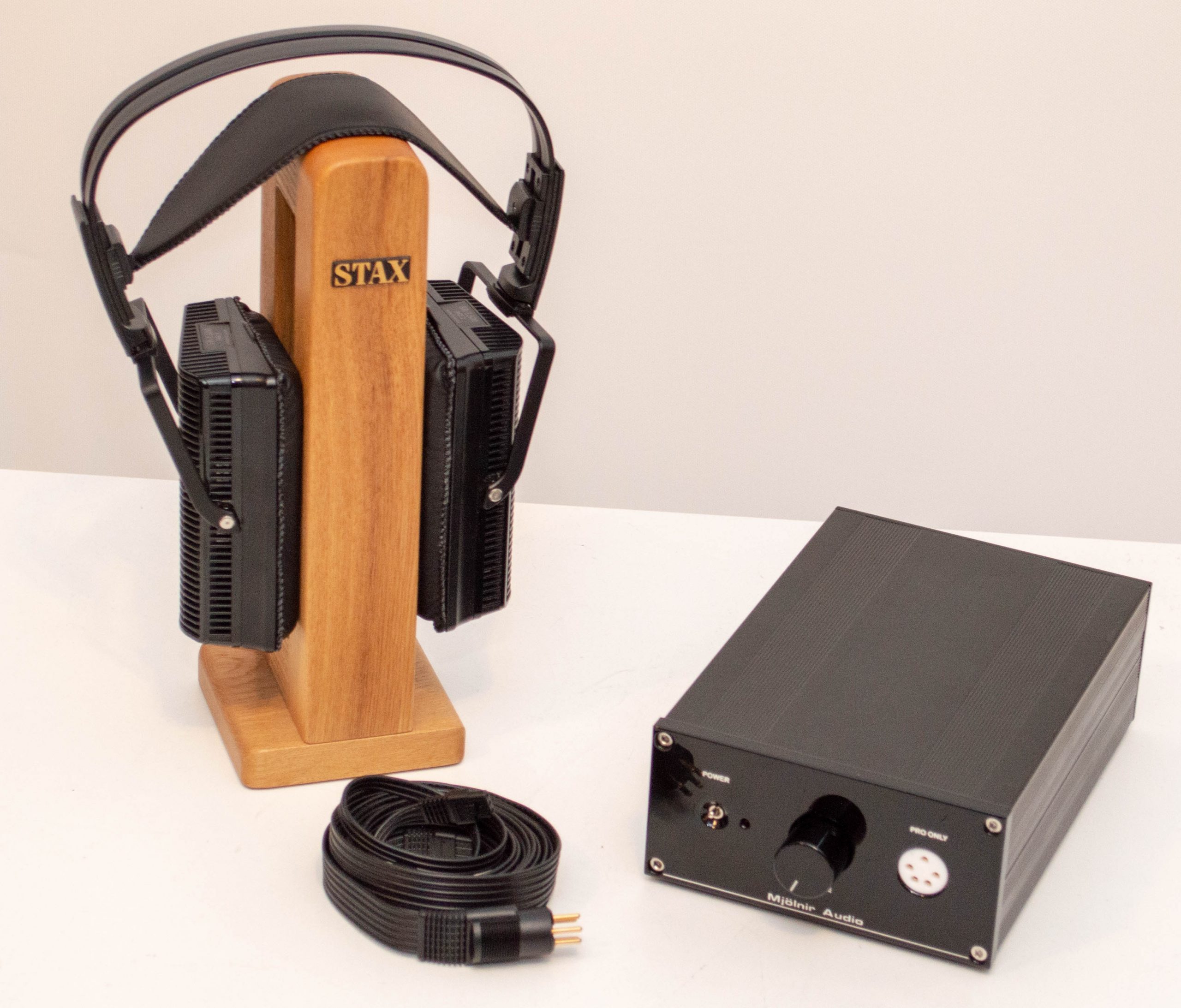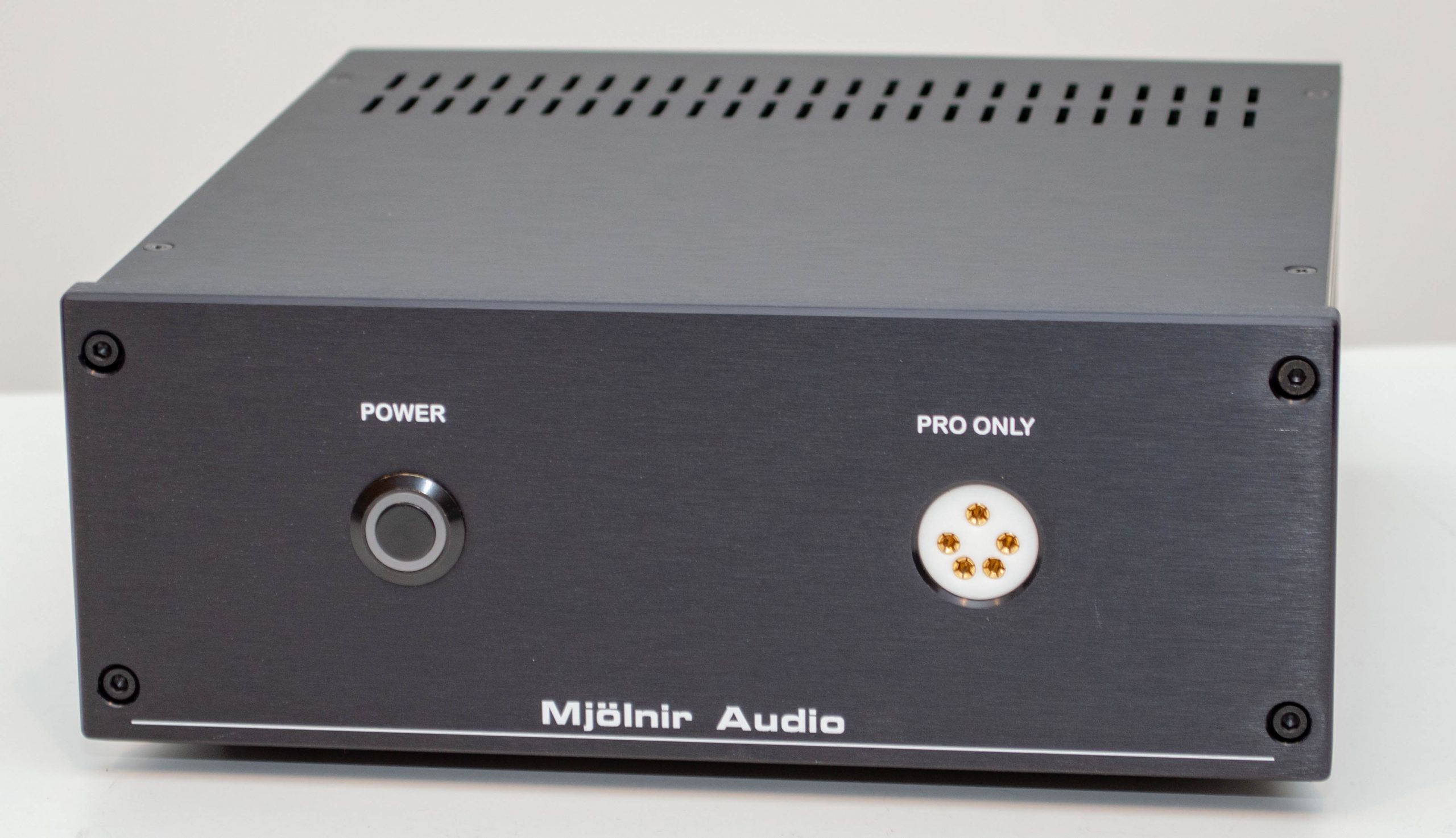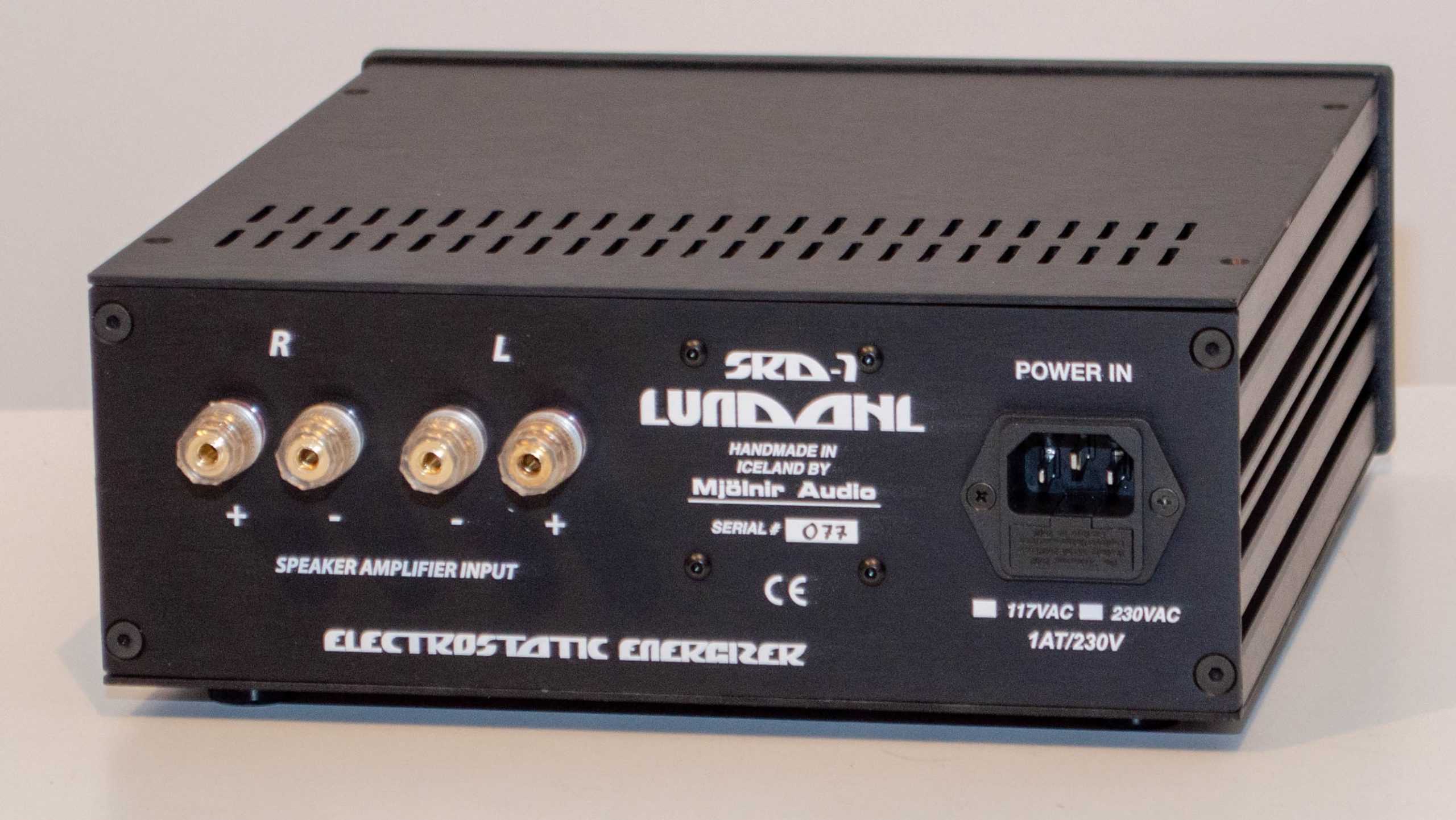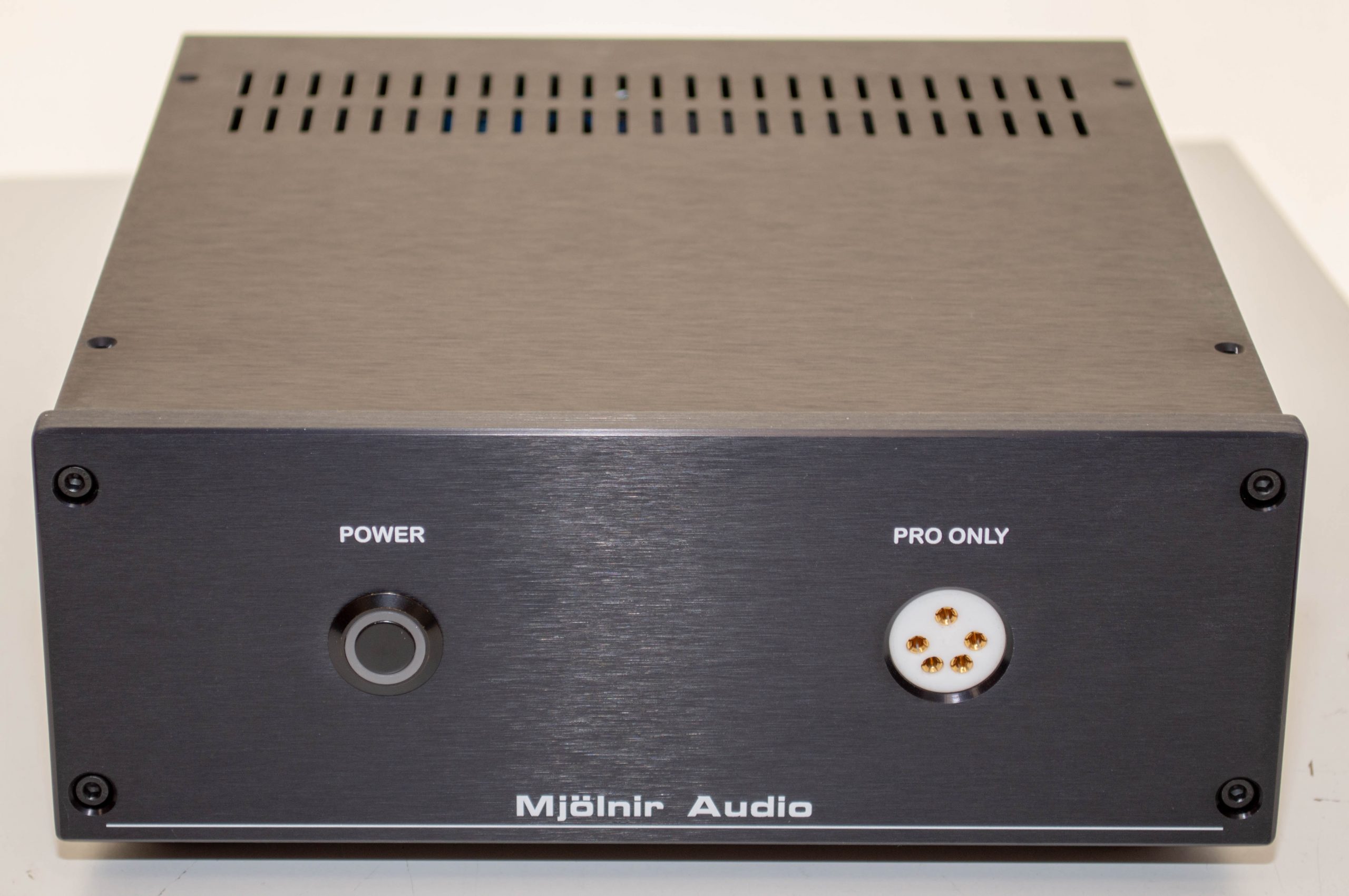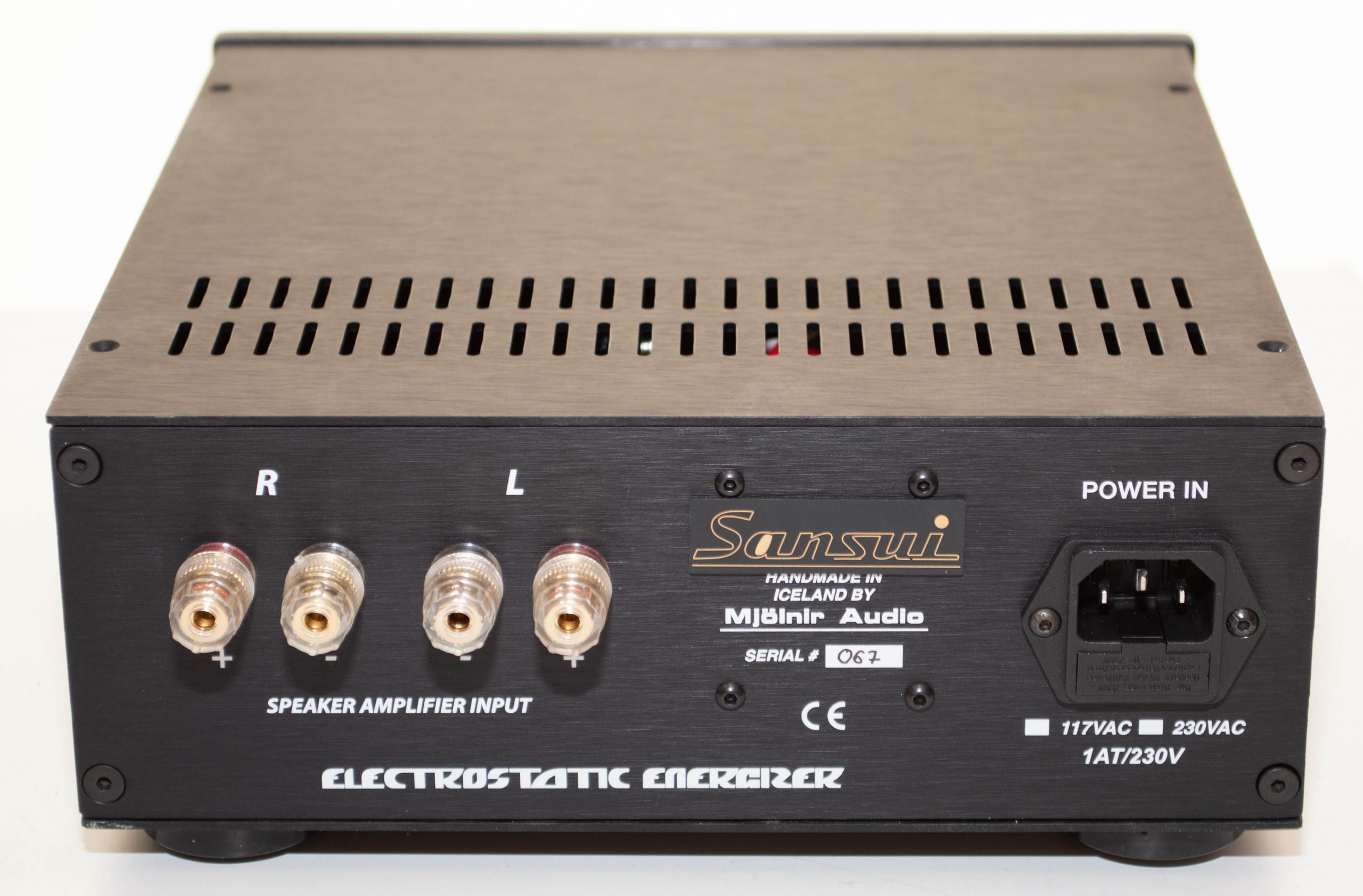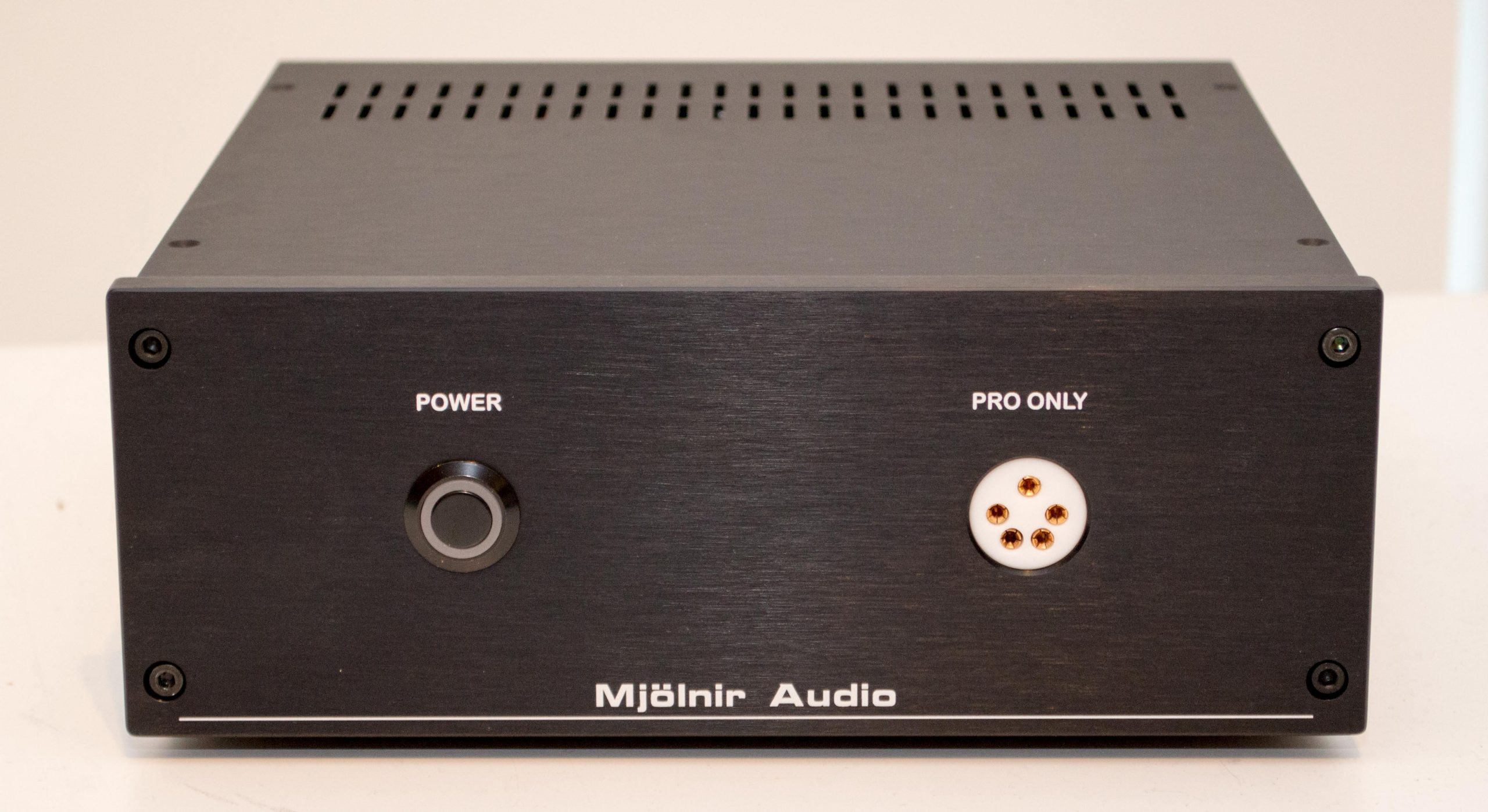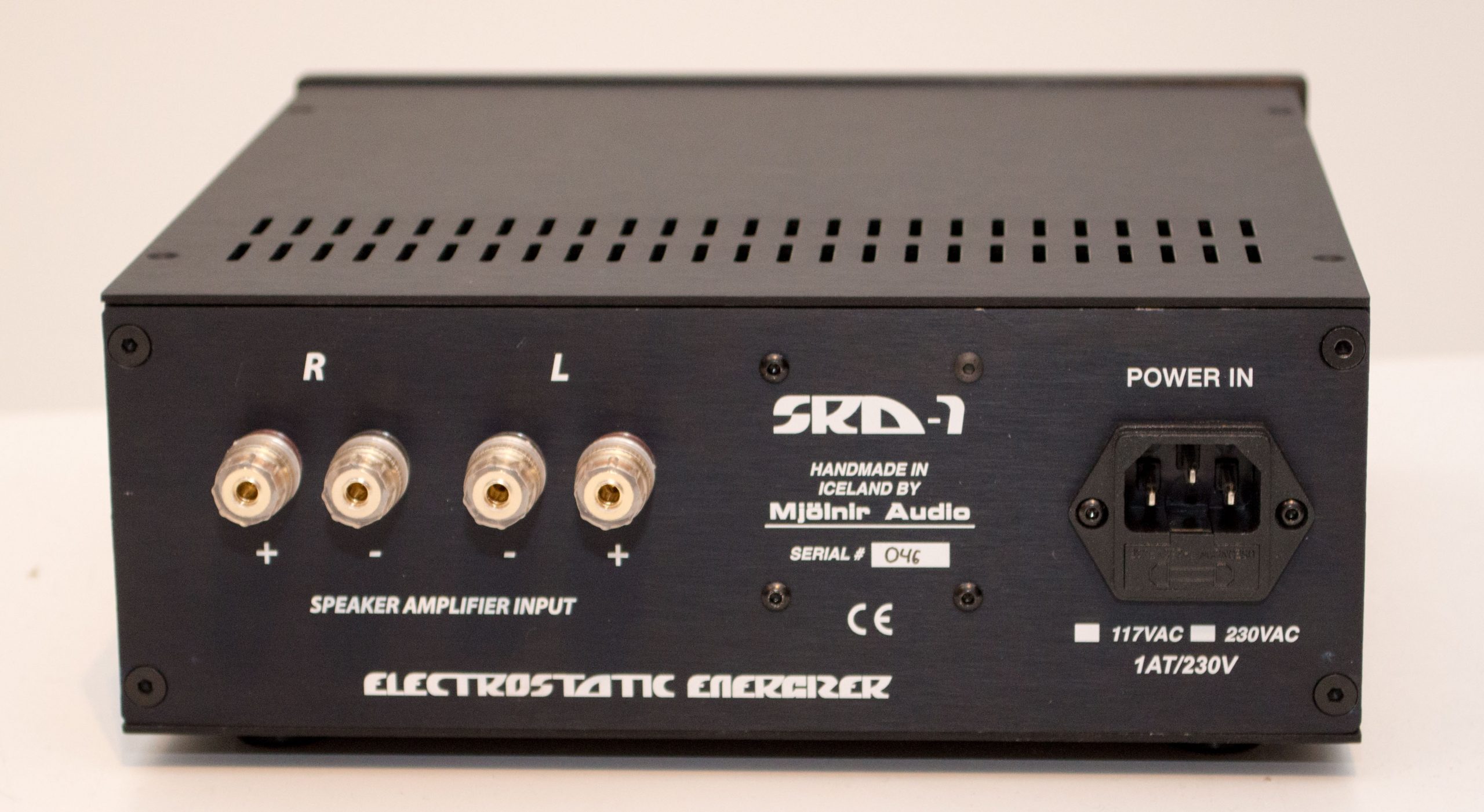Amplifiers for electrostatic headphones
Here is a rundown of any products I have in stock at any given time. Given the demands of my day job I do not accept orders ahead of time, I just sell what I’ve built. This also works better with the more experimental nature of what I do as we are always coming up with new designs and/or changing older ones. Feel free to contact me at spritzer@mjolnir-audio.com if you are interested in any item here. I will reply to every mail so if you haven’t received a reply within 24 hours then feel free to send me another email. Email gets lost all the time, it is flagged as spam or something like that. All prices in US dollars (USD).
The top of the line Carbon CC. This latest batch follows the same formula as my previous CC builds, I takes the Carbon amplifier channels but then everything is upgraded. Higher spec power supply, 99.99% pure silver signal wiring, upgraded TKD volume pot, higher grade resistors for the amplifier channels and finally, new custom made PEEK output sockets.
This latest batch has the front and back panels changed to a less glossy finish as I was having major issues with that supplier. That’s the only change though and I will continue to try and keep them in stock. I can also make a 100V version for Japan as they have been quite popular recently.
Price: 6900$ plus shipping
I have a few couple of extra versions of the Carbon CC in stock now. The first is the same as above but instead of the TDK volume potentiometer, it features a custom made 24 step stepped attenuator. Some prefer the extra precision from using stepped attenuators and they also help when using the amps with a preamp as they are effectively out of the circuit when set to the maximum level. Otherwise it is identical to the regular version.
Price: 7200$ stepped attenuator version plus shipping
Second, there is the RCA input version. This one looks the same, except there are 4 RCA’s on the back for input and loop output. I used to make these from time to time some 5 years ago but finally got around to making some again. They are identical to the regular CC, except it only has solid copper that are then rhodium plated RCA’s for input. The single ended input is then automatically converted to balanced at the first stage of the amp so it is fully balanced from then on out. Same exact performance as when using XLR inputs.
While making the small run of RCA units I decided to use up some of the attenuators I had in stock. The regular unit has a volume control using a high grade TKD volume pot with extra shielding to increase performance even further. Then there is a unit with a custom made 24 step stepped attenuator.
Finally I had just one each of these but one unit has a Penny&Giles RF15 volume pot and one has an Alps RK50. These are arguably the best volume control potentiometers ever made, the RF15 being long out of production and the RK50 now being end of life I won’t make any more of these.
Price: 7000$ for the RCA input version with a TKD attenuator plus shipping
7100$ for the RCA input with a 24 step stepped attenuator plus shipping
7700$ for the RCA input with a Penny&Giles RF15 volume pot plus shipping
This is the first electrostatic amp in the world to use SiC FET output devices which are as close to triodes as transistors can get. The original design concept for this amp was born to tame the rough top end of the SR-009 but it grew from there to become the best solid state amplifier we have designed. Right up there with the BHSE and the T2 as the best amps of their kind with all the power you could ever need. It has a lot of detail, huge and expansive sound stage and the best bass I’ve heard from an electrostatic amp.
With this new batch, the internals of the amp remain the same except all the Carbon’s now have a custom made TKD volume control. The front and back panels are now also different with a shiny, black electroplated finish plus some slight changes to the design. I can also make a 100V version for Japan as they have been quite popular recently.
Price: 5400$ plus shipping
It is finally ready, the new batch of the Novem. Back in 2020, when we all suddenly far more spare time on our hands, I built the Novem in a rather different chassis design. That was really me clearing house as a few different designs had been prototyped over the years but I finally had to sit down and finish the amps. Now the Novem is a major departure from the other amps on offer, as I normally strive for a neutral presentation with as much performance as is possible for the given design. Here though, it is designed to have a certain sound to suit the newer Stax models such as the SR-X9000 and SR-009S. It is a deceptively simple amp, just four tubes in total, two ECC83’s and two ECC99’s but each part is handpicked to get the right sound. It is neutral amp but it also tames the overly forward nature of these headphones and works with what they do well.
The amp circuit is identical to the older Novem units but with some small changes to the layout as I’ve had to substitute parts and just to make it neater. The power supply is based on the one in the original version but now incorporates a DC heater supply (linear, no switching supplies here) and an upgraded power transformer. The biggest change is the move to a dual chassis to keep as much noise away from the amp as is possible plus just superior parts where I could put them. The new umbilical cable was specifically chosen and fitted with some very nice Lemo plugs. The output sockets are genuine Stax units as I just happened to have a few of them in stock. RCA input sockets are low mass silver units and the internal signal wiring is naturally all silver in Teflon.
Price: 5200$ plus shipping
Now for something rather different, a current feedback electrostatic amp. More people are familiar with the CFA dynamic amp which has been quite popular but we did do an electrostatic version as well. I was never quite happy with how the DIY version sounded so I continued to tinker with it during Covid. These amps were supposed to be released then but no parts were available so it languished for a few years with the basic design ready and a prototype up and running. The part shortages finally lifted and I had enough stock to build a few dozen units plus enough stock for future repairs.
The CF circuit is very different from the usual designs of the KGSSHV and KGST, it’s simpler in some ways but more complicated in others. It uses a lot of parts which have to be matched thoroughly so quite parts intensive to create matching channels for each amp plus spares. The sound is warmer and more forgiving than the KGSSHV while having a bit more power on tap so it suits well with the newer Stax models, Audeze CRBN etc. No lack of extension and presence so just a nice, slightly different approach to those amps in a small package.
The chassis this one uses is similar to my old KGSSHV mini amps but it does mean it runs rather hot so it needs space around it to radiate. It was designed to run this hot so it is not a problem, just something to be aware of. It uses very high quality parts, such are my custom made PEEK output sockets, custom made TKD volume control, custom made transformers and finally a custom made power supply. The amps come preset to either 115V or 230V when shipping out like all of my other amps.
Price: 3500$ plus shipping
Now the KGST is finally available again. This amplifier has been called the mini BHSE and it is a fitting name. This is a hybrid amplifier and the circuit is similar to the BHSE in many ways. The power supply is similar and so are the first two amplifying stages. The main difference is with the tubes used and how they are used. The KGST uses the tube in a more traditional nature but with the same constant current source as the BHSE. The tubes used are the 6S4A and they handle the output directly with no extra stages needed. There are no external heatsinks and the tubes are fully enclosed in the chassis.
Sound wise they are very similar but the KGST is warmer and more forgiving making it a better match to the SR-009. Like the BHSE it runs very warm so it needs a lot of air to breath. Similar to the KGSSHV this one has a servo which monitors and corrects the output so warmup is less of an issue.
After many years of not changing the KGST at all, I finally altered the chassis layout a bit so it better matches my other amps. Small updates to the boards and circuit as well but nothing major.
Price: 3300$ plus shipping
Here is a new limited edition model to celebrate the KGSS circuit 25th anniversary, the KGSS Neo. At its core, it is the older KGSS circuit using NOS parts, but updated to remove the main limitations of that original design. It was styled to be similar to the amps I was building 15 years ago but using all the new circuits, the same power supply as the KGSSHV and it is fitted with the new PEEK output sockets. It’s a full size chassis but only 300mm deep so not as bulky as the older amps. The circuit hails from the old single board KGSSHV amps from back in the day, but heavily modified. In terms of performance, it is very close to the KGSSHV but designed to be a bit warmer and more forgiving, like the KGSS used to be. Voltage swing is roughly 1440Vppss (peak to peak, stator to stator) which is plenty for anything you throw at it. As with all my amps, it can be set to either 115V or 230V before shipping it out and can run natively with RCA to XLR adapters/cables for those needing a single ended input.
Price: 3300$ plus shipping
Finally ready is the new version of the KGSSHV. It’s really the first major change to the circuit in over a decade as I wanted to tie together the old KGSSHV performance with the warmer and more forgiving sound of the KGSS Klassik. All of the transistors have been changed in this version plus a number of other changes and all the heatsinks are now onboard to make it more similar to the KGST in looks. I did add the second output socket as it might help some users who want to use two sets at the same time.
The KGSSHV has been going strong for over a decade now and is the best solid state amp we’ve ever designed outside of the Carbon, which was heavily based on the KGSSHV. This one is warmer and more forgiving than the original design which suits the modern Stax models better as they are on the bright side.
Price: 2750$ plus shipping
Introducing, the new and improved Octave V4 solid state amp. I took the older V2 design (the V3 was a short lived power amp only version of the V2), improved on it, shrunk it down as far as I could and made it into a small desktop amp. It is fully balanced, all discrete, with premium parts and a R-core transformer. The chassis was also designed to have a solid top panel so headphones or something else could be stacked on top of the unit. While it is fully balanced, it could be used with RCA sources simply by using RCA to XLR adapters or cables with no loss in performance.
In terms of design, this is meant to surpass the Stax SRM-323S, 353X, 400S and 500T in every way by being more neutral and powerful. It’s no powerhouse so it will struggle a bit with the 007’s and 009’s but such a small design will always have its limitations. The circuit is a simplified take on the KGSSHV and highly optimized for this exact form factor. Voltage swing is roughly 1150Vppss and the unit is 220mm deep, 145mm wide and 73mm tall.
It’s hard to take good pictures of these, especially in the depth of winter here in Iceland but its glossy black. There are two versions of the front panel, mostly because I changed my mind in the middle of designing them. The first dozen units will have my familiar round power switch but all units from then on will have the toggle switch as seen in the last picture. This greatly simplified assembly and servicing so a welcome change for me. All of the units come with a voltage selector on the back panel so they are easy to change between 115V and 230V.
Price: 1300$ plus shipping
As an offshoot of the SRD-7 below, I’ve made a few units with Lundahl transformers instead of the Stax units. The rest of the circuitry is mostly the same except the Lundahl units are further upgraded with better power transformers, better parts and upgraded wiring. What the Lundahl transformers bring to the table is a much larger core, C-core at that, with very much improved wiring. They are a bit lower in ratio compared to the Stax units, so they need more voltage (or gain) to get get to the same output level. The lower ratio means less distortion and over all losses in the transformers too for much better performance.
They can be set to either 115V or 230V via the internal voltage selector and will be preset before shipping out.
Price: 1450$ plus shipping
Given how popular the Lundahl transformer boxes have been, it was bound to happen I’d try something different and here we have it, the Sansui version of the SRD-7. Now this uses all the same parts as the Lundahl but uses vintage Sansui transformers that were used in their legendary tube amps. Now sourcing these transformers has not been easy or cheap plus I needed to have some brackets custom made so they would fit in my standard SRD-7 chassis. These have a higher ratio than the Lundahl boxes (so they work better with lower power amps) plus a larger core and even better winding techniques so they offer even better performance. For now there is only one of these but I might make some more in the future if I can find more transformers and there is enough interest.
They can be set to either 115V or 230V via the internal voltage selector and will be preset before shipping out.
Price: 1600$ plus shipping – Out of stock while I try to source more transformers
People have been asking for years to do some transformer boxes (or energizers) to drive electrostatic headphones and here they are with a brand new version. Over the years I’ve accumulated a large number of Stax transformer boxes, some of which I have converted to pro bias but most have been scrapped. The only things I saved were the transformers and the Stax sockets. So what I did here is to put the excellent transformers into a much better enclosure with my own bias supply to maximize their potential. On top of that the input to the transformers is protected from overload and the output has a clamp circuit so it can never damage the headphones connected to it. This is a fully passive circuit which only kicks in if the transformer peaks at roughly 550Vpp, 1100Vppss. Any higher than that and you run the risk of damaging Pro bias headphones.
There is nothing here in the signal path except the transformers and the input protection circuitry. The left and right channels are also isolated so no issues with using bridged amps. A common ground will turn them into smoke right quick so I would never set it up like that. The boxes can be set for either 117V or 230V with an internal switch.
The latest version now has a new chassis design to be more inline with my other amps, R-core power transformer and numerous other improvements.
Price: 820$ plus shipping
Page updated 03.12.2025

